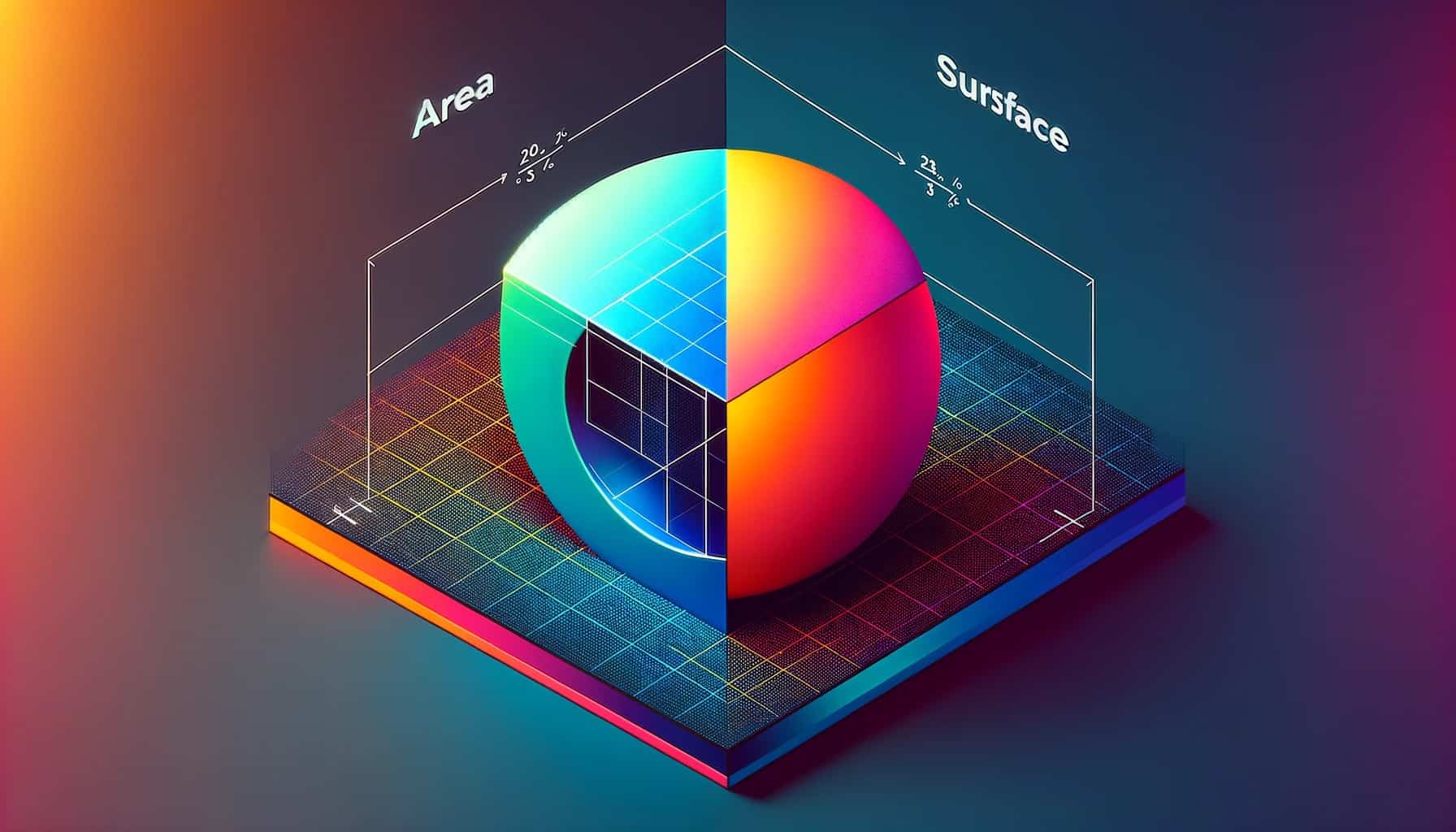Difference Between Area and Surface Area
by Yogi P - December 14, 2023
Area vs. Surface Area: Unraveling the Dimensions of Space
In mathematics and geometry, “area” and “surface area” are frequently used terms, especially when measuring and understanding the extent of spaces and shapes.
While these terms are often mentioned in similar contexts, they have distinct meanings and applications.
This article explores the differences between area and surface area, clarifying their definitions, uses, and significance in various fields.
What is Area?
The area is a measure of the extent of a two-dimensional surface or shape in a plane. It is expressed in square units (such as square meters, square feet, etc.) and represents the size of a flat surface. The area is used to determine the space contained within the boundaries of a two-dimensional figure like a square, rectangle, triangle, or circle.
Key Aspects of Area:
- Dimensionality: Area is a two-dimensional measurement.
- Calculation: Calculated based on the shape’s dimensions. For example, the area of a rectangle is calculated as length multiplied by width.
- Shapes: Applies to flat shapes like rectangles, circles, triangles, and polygons.
- Applications: Used in fields like architecture, land surveying, and interior design to measure spaces like rooms, plots of land, or surfaces.
What is Surface Area?
Surface area, on the other hand, is the total area covering the surface of a three-dimensional object. It is the sum of the areas of all the shapes that cover the surface of the object. Surface area is particularly relevant for three-dimensional objects like cubes, spheres, cylinders, and prisms.
Key Characteristics of Surface Area:
- Dimensionality: Surface area is a measurement of all the areas of the surfaces of a three-dimensional object.
- Calculation: Involves summing the areas of all the faces or surfaces of a three-dimensional object. For example, the surface area of a cube is 6 times the area of one face (since a cube has 6 identical faces).
- Shapes: Applies to three-dimensional objects like spheres, cylinders, cubes, and prisms.
- Applications: Important in fields such as physics, engineering, and manufacturing, where the properties of physical objects are crucial.
Tabular overview of the Differences Between Area and Surface Area:
| Aspect | Area | Surface Area |
|---|---|---|
| Definition | The measure of the extent of a two-dimensional surface or shape. | The total measure of all the surfaces of a three-dimensional object. |
| Dimensionality | Two-dimensional (2D). | Three-dimensional (3D). |
| Calculation | Based on the dimensions of the shape (e.g., length × width for a rectangle). | Sum of the areas of all the faces or surfaces of an object. |
| Applicable Shapes | Flat shapes like rectangles, circles, triangles. | Solid objects like cubes, spheres, cylinders. |
Understanding Through Practical Examples
- Area Example: Calculating the area of a garden to determine how much grass seed is needed. If the garden is a rectangular shape, the area is calculated by multiplying its length by its width.
- Surface Area Example: Calculating the surface area of a water tank to determine the amount of paint required to cover it. This calculation would sum the areas of all sides (or faces) of the tank.
The Role of Area and Surface Area in Practical Applications
Understanding area and surface area is crucial in various real-life applications:
- Area is used in planning and constructing buildings, crafting items like carpets, and in agricultural planning.
- Surface Area is essential in manufacturing, packaging, and in scientific fields where the properties of surfaces (like rate of reaction in chemistry) are important.
FAQs on Area and Surface Area
Q1. Can the area and surface area be the same for any shape?
No, the area and surface area cannot be the same for any shape, as area pertains to two-dimensional shapes while surface area pertains to three-dimensional objects. They are fundamentally different measurements.
Q2. Is it possible to calculate the surface area of irregular shapes?
Yes, it is possible to calculate the surface area of irregular three-dimensional shapes. This typically involves breaking down the shape into simpler, measurable parts, calculating the area of each part, and then summing these areas.
Q3. How do units of measurement differ when calculating area and surface area?
The units of measurement for both area and surface area are squared units (e.g., square meters, square feet). However, the application differs as area is used for two-dimensional spaces and surface area for three-dimensional objects.
Q4. Why is understanding surface area important in industries like pharmaceuticals?
In industries like pharmaceuticals, understanding the surface area of particles can be crucial as it affects the dissolution rate of drugs. A larger surface area allows for faster dissolution, which is important for the effectiveness of the medication.
Q5. In geometry, is it more challenging to calculate area or surface area, and why?
Generally, calculating surface area can be more challenging than calculating area, as it often requires finding the areas of multiple faces of a three-dimensional object and then summing them. This can be particularly complex for irregularly shaped objects. In contrast, calculating the area of two-dimensional shapes is usually more straightforward.
Conclusion
In summary, area and surface area are critical measurements in mathematics and geometry, but they apply to different dimensions of shapes. The area is concerned with the size of a two-dimensional space, while surface area deals with the total area of the surfaces of a three-dimensional object.
Recognizing the distinction between these two concepts is essential for accurately calculating and applying these measurements in various scientific, educational, and practical contexts.
Whether you are designing a building, planning a garden, or calculating materials needed for a three-dimensional object, understanding the difference between area and surface area is key to achieving accurate and useful results.









